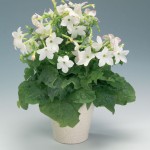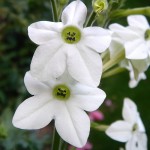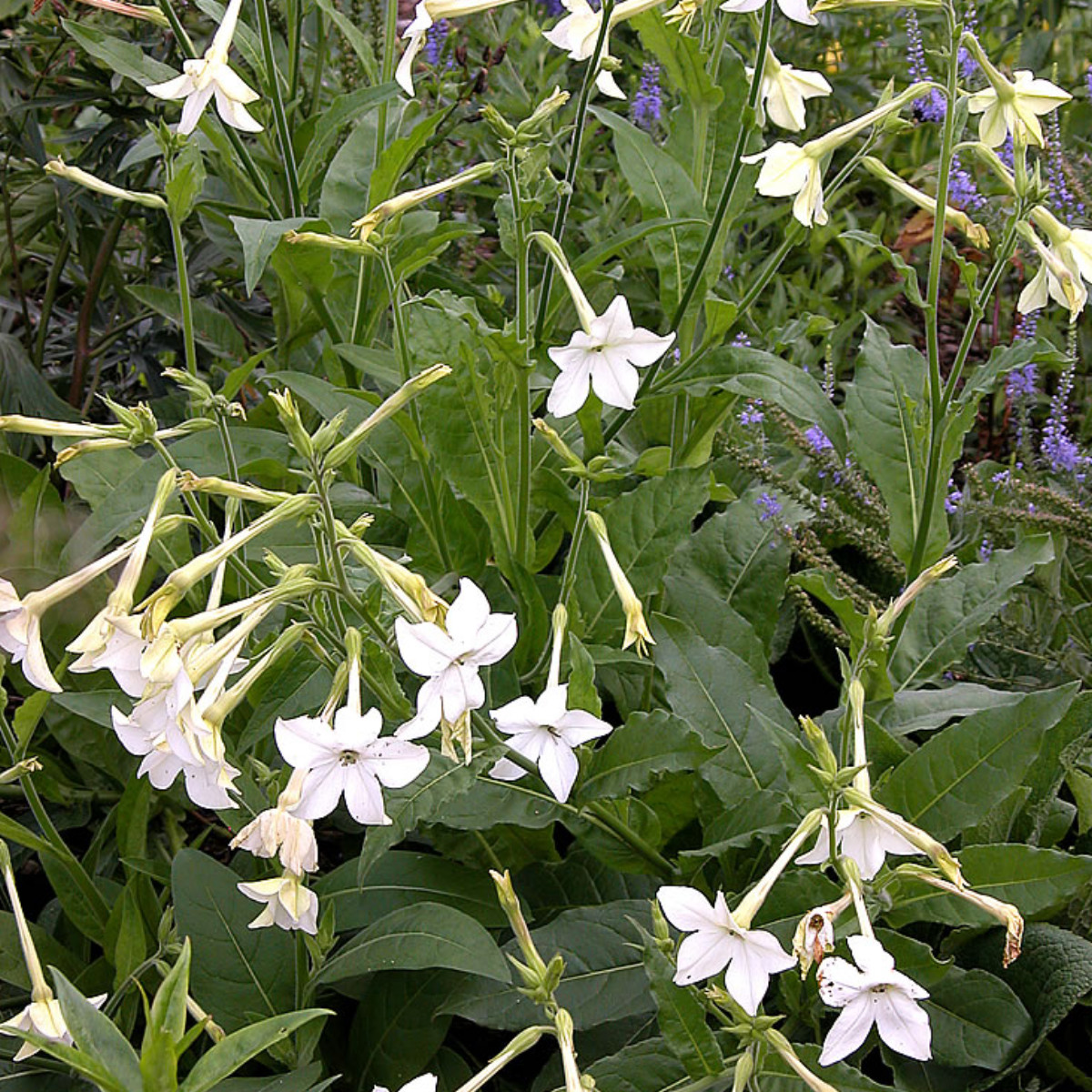Family: Solanaceae
Synonymous: Nicotiana affinis
Nicotiana affinis var. grandiflora
Nicotiana alata var. grandiflora
Distribution and habitat: Nicotiana alata is native from southern Brazil to northeastern Argentina. It is a species of tobacco which is grown as an ornamental plant for both elegant looking and beautiful scent.Nicotiana alata is now available in a wide range of varieties and hybrids. Most of the popular cultivated varieties of ornamental Nicotiana are developed from this plant.
Description: Nicotiana alata is tender perennial that is often grown as annual. This species of flowering tobacco is a somewhat spindly plant that typically grows 90-120cm (36-48 inch) tall and features nocturnally fragrant, long-tubed, yellowish-green to white flowers that open only at night. Spatulate basal leaves to 30cm (12 inch) long are attached by distinctive winged petioles. Upper stem leaves are much smaller and sessile. The branched flower stalks produces white flowers that release their intense fragrance when they open at night. It has bigger flowers than other tobaccos do, about 8cm (3 inch).
Nicotiana alata is appreciated for its perfume. Bloom starts in in early summer and continues into fall in a protected spot.
Garden Culture:Nicotiana alata is usually grown as an annual, flowering well in its first year, but it does survive mild winters outdoors.
During the height of its blooming in hot weather, Nicotiana alata appreciates some help to continue flowering profusely. Once the first flush of blooms is past, deadhead the plant to remove spent flowers. If intended to allow the plants to self-seed prolifically, leave spent flowers in place, but the plant will not be as attractive.
Position: Give them full sun or partial shade.
In areas with hot summers plant Nicotiana alata in a location with afternoon shade.
This plant requires more than 14 hours daylight per day to induce flowering.
Soil: They grow in well-drained soil enriched with organic matter, such as compost or peat moss. Plants grow best in soil that has been loosened before planting to allow ready penetration of oxygen and water. Spread organic matter such as compost, peat moss, well-rotted manure or leaf mould over the area to be prepared, then turn it into the soil.
Seedlings do best when gradually introduced to outdoor environment over the course of a week. Set plants outdoors in a sheltered, lightly shaded spot, increasing their exposure to sun and wind each day. After this period, they will be ready to go in the ground. Before planting, water thoroughly the potting mix. Then dig a hole just slightly larger than the pot. Remove the plant from the pot by grasping the rim, turning the pot upside down and tapping it against the heel of the hand. If the plant is root-bound, gently break up the sides of the ball with the thumbs and tease apart roots that are circling at the bottom. This operation encourages the roots to grow out of the potting mix and into the surrounding soil. Set the root ball in the hole so that the top of the ball is level with the surface of the soil. Then push soil around and just over the top of the root ball, firm the soil, and give the plant a thorough soaking to settle the soil.
Irrigation: Water thoroughly after planting and keep a close eye on the plant over the following week. If they wilt on a hot, sunny day, check the soil to a depth of about 3cm (1 inch). If dry, water thoroughly. If the soil below the surface is moist to the touch, do not water. The plant is probably wilting because the roots are not well established yet. The remedy is to provide some shading the plant if applicable. Within a week or so, the roots should catch up and the shading can be removed.
After the first week, give a new plants a good soaking once a week during summer, unless there is more than 3cm (1 inch) of rainfall per week. Established plants can get by on less water, but most grow best if the soil remains evenly moist. Do not overwater the plants.
Fertilising: Use a slow release fertiliser around the feet of annuals at planting time. When plants are established, applying a water-soluble fertiliser at half or quarter strength every other week in summer.
Window boxes & tubes: Give tall specimens grown outdoors some support, otherwise the stems with flowers may break off in windy weather.
Position: Grow Nicotiana alata in full sun, although they will tolerate some shade. If growing in a greenhouse or conservatory, protect them from strong sunlight.
Potting mixture: Use a soil based potting mixture that is light and fertile.
Watering: Water the plants moderately at regular intervals. The taller the plants, the more often they will need watering.
Feeding: Feed about once a week throughout the summer with a standard liquid fertiliser.
Propagation: Nicotiana alata can be raised from seed. Sow the seeds on surface in early spring in propagating trays using a seed-sewing compost. Keep them in a warm place and cover the seed tray with glass or polythene. Remove the cover regularly to prevent excess condensation. The seed usually germinates in 10 - 20 days at 20C (68F).
Give the seedlings good light and keep the soil moist. Once they are large enough to handle, pick them out into individual pots. Peat pots are preferable as they can be placed intact into a large tub. In middle spring the new plants can be planted outdoors safely.
This pants tend to self-sow if the spent flowers are left on plant.
Problems: Nicotiana alata is generally a very healthy plant with no diseases and few pests.
Pale or yellow leaves and poor growth are caused by aphids.
Treatment: In minor attacks, wash the pests away with a strong spray of soapy water and repeat is necessary. Severe attacks should be treated with an adequate insecticide.
The stems and stalks of tall plants snap off in windy weather.
Prevention: If the plants are grouped close together they will give each other some protection, but tying them to a cane is the best solution.
Availability: Nicotiana alata seedlings or seed packets are available at nurseries and garden centres.
Lifespan: Nicotiana alata is an annual that will die down in the autumn. In good position,Nicotiana alata will produce a wealth of blooms from summer through fall.
Uses: Nicotiana alata are ornamental perennials or annual border plants in a cottage garden designs. It is grown for its colour and perfume suitable in any garden. Plant them near a door or window and get their perfume indoors. It is great planted along walkways, near garden benches, around decks and patios or other places where people congregate.
Nicotiana alata is a lovely summer annual that is easily grown outdoors in pots or tubs, preferably near a window or door so its fragrance can be fully appreciated.
Toxicity: All parts of this plant are poisonous if ingested.
Height: 90-120cm (36-48 inch)
Spacing: 38-45cm (15-18 inch)
Hardiness zone: 10-11





